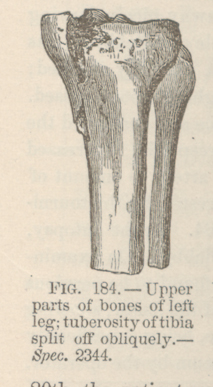Title: Briot, C.
Source text: The Medical and Surgical History of the War of the Rebellion. (1861-65.), Part 3, Volume 2 (Washington, DC: Government Printing Office, 1883), 243-244.
Civil War Washington ID: med.d2e11345
TEI/XML: med.d2e11345.xml
CASE 450.—Private C. Briot, Co. C, 39th New York, aged 26 years, was wounded in the left knee, at Bristoe Station, October 14, 1863. He was conveyed to Alexandria on the following day, and admitted to the First Division Hospital, whence Acting Assistant Surgeon C. W. Koechling transmitted the pathological specimen (FIG. 185), with the following history: "The wound was caused by a minié ball entering the external aspect of the knee, passing through the joint, and lodging. The missile was extracted from the internal aspect of the leg, on the field, by the regimental surgeon, and the limb was amputated at the lower third of the thigh, by the circular method, on October 16th, by Acting Assistant Surgeon N. Barnes. The patient came under my care on October 26th, at which time the bone protruded from the stump over an inch. For this gentle attraction of the integuments was made by adhesive strips and kept up for a week, when, the patient suffering too much pain, it was continued no longer, and a roller was applied from above downward and kept on until the bone was nearly covered. The patient improved every day, there being but very little discharge, but occasionally very severe pain in the stump. On February 8, 1864, the accompanying sequestrum was removed. On February 20th, the patient was seized with tetanic pains, which, though relieved by the free administration of opium, recurred every other day for a month. After that period the patient did well, and was able to take exercise on crutches, the stump having healed. On May 9th, the patient left the hospital on furlough." He subsequently passed through different hospitals, and lastly entered De Camp, David's Island, New York Harbor. On September 19, 1865, the man was discharged from service and pensioned. The upper portion of the bones of the leg of the amputated limb were forwarded to the Museum by the operator, and are represented in FIGURE 184, and a cast of the stump was contributed by Acting Assistant Surgeon G. F. Shrady. (Cat. Surg. Sect., 1866, p. 548, Spec. 1787.) The New York City Examining Board certified, March 11, 1874: "The pensioner is unable to wear an artificial limb in consequence of excessive tenderness of the stump, rendering him unable to stand the pressure upon it. He has tried one several times, but it was so painful that he could not wear it more than a few hours." This pensioner died November 12, 1877, of phthisis pulmonalis.

